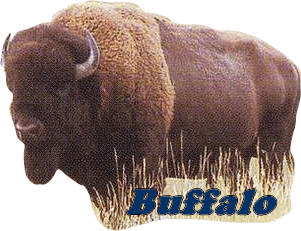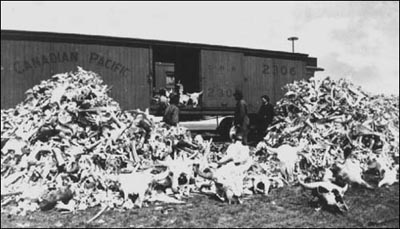|
|
|||||||
| Most people know about the Indians and what they did. But most don't know what they did with the buffalo when they killed them. | 
This is the most common buffalo the Indians hunted. |
||||||
| How the Indians killed the buffalo- Before guns and horses were invented the Indians hunted the buffalo by foot. When they got more creative they used spears and bows and arrows for the hunt. The "Buffalo Pound" and "Buffalo Jump" were was to kill large numbers of buffalo. Buffalo Pound method- The buffalo were lead in to an area where other hunters would be waiting to attack them with spears. Buffalo Jump- The "chasers" or "runners" would lead the animals toward a cliff where the other hunters waited behind rocks and trees. When they were doing this other people would be waving blankets and shouted forcing the animals over the edge of the cliff. The hunters at the bottom would be waiting for the buffalo to jump. When they did this the Indians would kill the crippled buffalo. | |||||||
| Some men covered them selves in buffalo robes or wolf skins and waited for the best time to kill. Hunting parties would also drive the buffalo in to deep snow and kill them there. Others drove the buffalos in to large bodies of water where the buffalo were unable to get away. Chase method-The chase method was used if the Indians had horses. They would chase the buffalo and try to get as close as they could and they then would shoot them with a gun or a bow and arrow. In summers bands of hunters would get together and hunt. This killed way more buffalo and they got more meat. When they had horses and guns it was way more easy for the people to kill the buffalo. As more people came to the Plains more buffalo disappeared. By 1880 the huge herds of buffalo had disappeared. Bison had become the most hunted animal on the Plains. | |||||||
| The plains Indian people thought that the buffalo was a gift from the Creator. The buffalo meant a lot of different things to most of America's Native people's. They were food, clothing, tools, and almost everything they had. A lot of Indians used the buffalo for their dances. Most tribes used every part of the buffalo, but there was one tribe that didn't. The Kootenai would throw away all the insides except the heart. The Indians life revolved around the buffalo. They moved with them during all but the winter months. | |||||||
|
|||||||
|
The Sun Dance The origin of the sun dance is traced to the buffalo. Before the dancing began, a sacred sun dance pipe was filled and sealed with fat from a buffalo's heart. Laubin said that the Sioux dance leader threw himself prone on the ground, west of the scared buffalo skull. As a major animal represented in sun dance, it has both spiritual and physical ties to human kind. For Plains Indianans today the buffalo retains its symbol importance. Many tribal leaders are trying to bring back the buffalo. How the Indians used the Buffalo- The Indians used every part of the buffalo. They never wasted any part of it. The most useful part of the buffalo is the hide. The thickness and the uses varied by the age and the sex of the buffalo. Thinnest was that of unborn calves for berry bags. The Indians treated the skins to give them different things the needed. Rawhide was tough and stiff in texture. For winter garments and blankets the hair was left on the hide. Other used hide were scraped clean. Sometimes the hide lasted so long it was used for tow different purposes. Upper parts were made rain proof by the grease and smoke of many cooking fires. Indian women would stitch it for the wet seasons. Both the men and the women butchered the buffalos. The Blackfoot considered the butchering for the men, other people recognized the chore as a men and women chore. |
|||||||
|
Religious Matters If a child's name had the word "buffalo" in it the Indians believed that the child would be especially strong and would mature quickly. These children usually fulfilled the expectations of others by striving to accomplish what his name implied. If a winner was renamed after a vision or a great hunt and his name had "buffalo" in it than that meant the buffalo was his super natural helper, or that he had the strength of a buffalo. Holy men who was buffalo in the vision would seek there after to commune with the Great Spirit through the buffalo.
|
|||||||
| Buffalo calling was a constant practice on the Plains. Whenever the season came for the great hunt the Indians would then "call" the buffalo. The calling wasn't a call that you think it would be. The call they used was a ritual. They used buffalo hair, and the Blackfoot used stones that looked like buffalo for the calling. These stones were called "buffalo stones". Each tribe had some kind id special song that they sang. When they sang their songs they believed it would make the buffalo approach their camp site. Comanche hunters would find a horned toad and they would ask it where the buffalo were. Of course the toad wouldn't tell them where the buffalo were, but wherever the toad scrambled off than that was where the buffalo were. Some tribes had a hoop game which "called" the buffalo to them. Blood was drank just to quench their thirst. Often the chase of a herd lasted for hours. They usually made their kill far away from any water so they drank the blood as water. When tribes went in large groups to kill they would get loads of meat. They had parties when they killed so many. Several pounds of meat was eaten by each of the men. | |||||||
|
End of the Buffalo "Kill off the buffalo and you kill off the Indians." said Sherdian. If the buffalo were to disappear, the Indians would starve and their tribes would then be forced off to reservations the whites chose to put them on. In 1800 there were about 60 million buffalo on the Plains. 70 years later the numbers dropped down to about 1,000. The slaughter began in the early 1860's with the building of the railroad. Rather than pay for meat the railroad workers would pay hunters to come and kill the buffalo for food. When this started buffalo hunting became a great source of entertainment for sports men who went out West in railroad cars. With the slow moving cars they shot the buffalo while sitting in the cars. "A uniquely American Scene." reported one British traveler. The people skinned the buffalo and sold the hides as leather. They then would sell it for $3.00. The hunters would kill about 50 buffalo a day. Some people said they would kill 1,500 in a single week. "When you killed off the buffalo you also killed off the "Wild Indians"." Lame Deer said. He also said the white men said that the buffalo were stupid because they were to easy to shoot, they weren't afraid of the gun. Without the buffalos all the Indians could not have survived, at least not on the Great Plains. |

These are all the buffalo that the whites shot. They are shipping off the heads to be sold. |
||||||
"A cold wind blew across the prairie when
the last buffalo fell..... a dead wind for many people."
Unknown. Native people of the Plains respected and honored the
buffalo through songs, dances, and ceremonies. Not very many people realized
this.
|
|||||||
Revised: February 05, 2004 . |
|||||||
